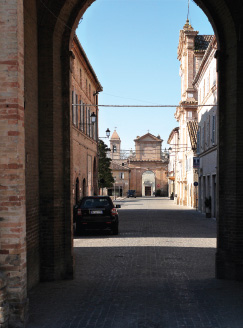![]()
MANY visitors to the Marche search out medieval and Renaissance monuments. And this is wholly understandable. But there is also much of later periods to see. Thus, if the beautiful Barocci at Senigallia is inaccessible, we can always linger in Pietro Ghinelli’s circular Foro Annonario, the neoclassical masterpiece of an obscure local architect.
Sometimes it is the less grandiloquent that takes us most surely to the spirit of a lost age. So it is at Penne San Giovanni, birthplace of the still-life painter Mario Nuzzi dei Fiori, where a handful of patrician families supported the Settecento theatre, a happy survival with its prettily decorated boxes, hardly larger than a drawing room. Penne is on a ridge above the valley of the river Tenna. Below, and on the opposite (right) bank, is an unexpected apparition, a small eighteenth-century town. In 1771 the town of Servigliano, a few kilometres to the south, was destroyed by a landslide. A year later Pope Clement XIV ordered that a new town, Castel Clementino, be founded on a lower and less vulnerable site. Work was continued under his successor, Pope Pius VI. In 1863, after the reunification of Italy when it was no longer fashionable to celebrate the legacy of papal rule, the new town was given the name of its predecessor.
Servigliano is a textbook model town of its period, square in plan, entered by three elegant gates, with two main streets that intersect in a generous piazza in front of the handsome church. It boasts no great work of art; it can claim no individual building of particular importance. But it has the merit of being largely intact, and is moreover accessible in the early afternoon when even the most determined sightseer will not be able to gain access to the wonderful polyptych by Carlo Crivelli at nearby Massa Fermana, or those by his son Vittore at Monte San Martino diagonally across the valley.

View northwards from the south gate, with the church on the right.